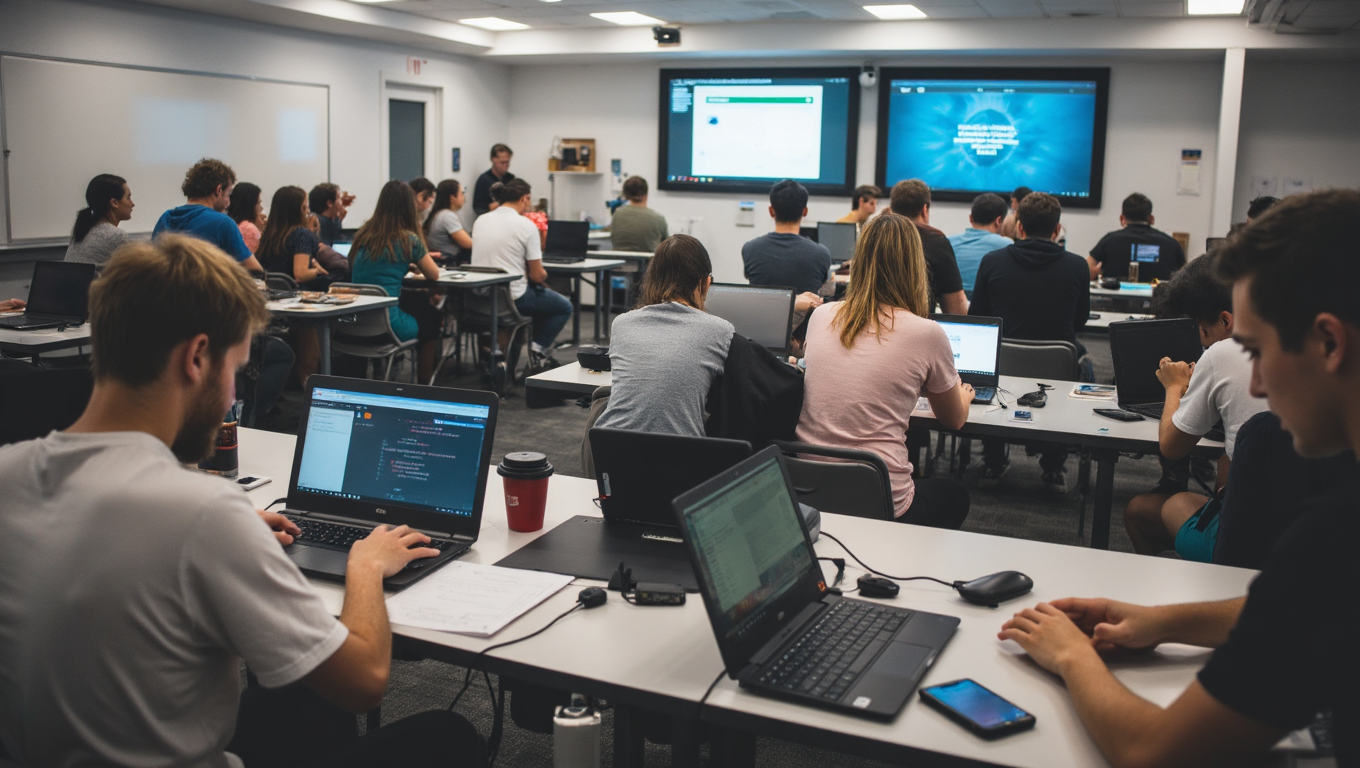Imagine a classroom where every student has access to the latest tools for creativity and collaboration. A space where coding meets storytelling, and projects come alive through teamwork. Welcome to the world of GitHub and IO!
As we step into 2025, these platforms are transforming education by providing students with essential skills for their future careers. Whether it’s sharing code or building interactive web applications, GitHub and classroom 30x.io make it easy for educators to enhance learning experiences.
Join us on this journey as we explore how you can integrate these powerful tools into your classroom effectively. From set-up tips to real-world success stories, you’ll discover everything you need to create an engaging environment that prepares students for tomorrow’s challenges. Let’s dive in!
Understanding GitHub and IO
Classroom 30x.github.io is a platform primarily used for version control and collaborative coding. It allows multiple users to work on projects simultaneously while keeping track of changes. This fosters teamwork, as students can contribute code or feedback seamlessly.
On the other hand, GitHub.io serves as a hosting service that lets you showcase your projects online. Students can create personal websites or project pages, making their work accessible to peers and potential employers alike.
Both platforms utilize Git technology, enabling efficient tracking of edits and updates in real time. This means that students not only learn how to write code but also gain valuable skills like project management and digital collaboration.
Navigating these tools may seem daunting at first glance, but they offer intuitive interfaces designed especially for new users. With some exploration, anyone can master them quickly!
Why GitHub and IO are important for classrooms
Classroom 30x.github.io games and IO play a pivotal role in modern education. They foster collaboration among students, allowing them to work on projects together regardless of their physical location. This aspect alone transforms traditional learning dynamics.
These platforms enhance coding skills and promote problem-solving abilities. Students can access resources, share code, and receive feedback from peers or instructors instantly. Such an environment encourages innovation.
Moreover, classroom 30x.github is widely used in the tech industry. Familiarity with it prepares students for future careers by giving them real-world experience early on. Understanding how to manage repositories also builds organizational skills essential in any profession.
IO versions complement this by providing interactive environments where learners can experiment with ideas without fear of failure. This hands-on approach cultivates creativity while ensuring technical proficiency develops naturally through practice.
Benefits of using GitHub and IO in the classroom
Integrating GitHub and IO into the classroom comes with a myriad of benefits that can enhance the learning experience.
One significant advantage is collaboration. Students can work together on projects in real-time, fostering teamwork and communication skills. This interactive environment encourages peer feedback, which enhances understanding.
Another benefit is version control. With classroom 30x github students learn how to track changes in their code or documents effectively. This skill not only helps prevent data loss but also teaches responsibility for their contributions.
Additionally, using these platforms introduces students to industry-standard tools early on. Familiarity with GitHub prepares them for future careers in tech or related fields.
Accessibility is another key factor; resources shared on GitHub.io can be reached from anywhere at any time, promoting flexible learning opportunities outside the traditional classroom setting.
Engaging with open-source projects through these platforms nurtures creativity and critical thinking skills as students tackle real-world challenges.
Step-by-step guide on how to set up a GitHub and IO classroom
Setting up a GitHub and IO classroom can be straightforward with the right approach. Start by creating a GitHub account for each student. This is essential for accessing resources and collaborating on projects.
Next, organize your classroom repository. Create folders for different subjects or projects to keep everything tidy. Encourage students to contribute by uploading their code or assignments directly to these folders.
Utilize GitHub Pages to create an accessible website where class materials reside. You can host project demos, presentations, or even interactive quizzes here.
Integrate IO versions into your curriculum by selecting relevant online tools that support engagement through coding challenges and games. Ensure students understand how to navigate these environments safely while learning effectively.
Schedule regular check-ins to discuss progress and troubleshoot any issues that arise during use. This will foster a collaborative atmosphere while promoting continuous learning in technology-rich settings.
Examples of successful classrooms using GitHub and IO
One standout example is a high school coding club that utilized GitHub to manage projects. Students collaborated on software development in real-time, learning version control while fostering teamwork skills. This hands-on approach helped them understand practical programming concepts.
Another inspiring case comes from a university where professors integrated classroom 30x github io for project presentations. Students showcased their work through personal web pages, gaining experience in both coding and digital communication. The result was an engaging platform for peer feedback and interaction.
An elementary school adopted IO versions for interactive storytelling sessions. Children created animated stories using simple code snippets, making learning fun and dynamic. Their excitement not only enhanced creativity but also improved technical literacy at an early age.
These classrooms illustrate the versatility of GitHub and IO tools across different education levels, demonstrating how they can enrich learning experiences in diverse subjects.
Tips for using GitHub and IO effectively in the classroom
Encouraging collaboration is key. Create group projects where students can contribute code and build upon each other’s work. This fosters teamwork and enhances peer learning.
Regular feedback is crucial for improvement. Utilize GitHub’s pull requests feature to provide constructive insights on student submissions. It helps them learn from mistakes.
Make use of branches in classroom.30x.github to allow experimentation without affecting the main project. Students can test new ideas freely, promoting creativity and innovation.
Integrate online resources with IO versions for interactive lessons. Use tools that make coding fun, such as gamification elements that keep students engaged while they learn.
Ensure all users understand best practices for security and privacy when using these platforms. Teaching responsible usage will create a safe environment for exploration and development in their coding journey.
Predictions for the future of classroom technology in 2025
As we approach 2025, classroom technology is set to transform dramatically. Artificial intelligence will play a central role in personalizing learning experiences. Imagine AI tutors that adapt to each student’s pace and style.
Virtual reality will redefine engagement. Students could explore historical events or distant planets without leaving their desks. The immersive experience promises deeper understanding.
Collaboration tools will evolve too. Enhanced platforms may allow real-time project collaboration among students worldwide, fostering global connections and diverse perspectives.
Data security and privacy concerns will become paramount as more schools adopt technology solutions. Future classrooms must prioritize safe digital environments for all learners.
Gamification of education could gain traction, turning lessons into interactive games that motivate students while they learn essential skills like problem-solving and critical thinking.
All these advancements indicate an exciting future where learning becomes more engaging, personalized, and connected than ever before.
Conclusion
The integration of GitHub and IO into classroom settings is transforming the educational landscape. As we move towards 2025, the importance of these platforms will only continue to grow. They not only enhance collaboration but also empower students with essential skills for future careers.
Accessing Classroom 30x GitHub and leveraging GitHub.io can open doors to a wealth of resources. Educators who embrace these tools are better equipped to engage their students in meaningful ways. The benefits are clear: increased student involvement, improved coding skills, and access to an expansive network of knowledge.
Successful case studies highlight how classrooms using GitHub and IO see tangible improvements in student outcomes. Teachers adopting innovative practices find that they can inspire creativity while ensuring safety online through proper guidelines.
As technology evolves, so too should our teaching methods. Navigating this digital landscape requires adaptability from both educators and learners alike. By focusing on safe usage, game-based learning opportunities, and effective navigation strategies, schools can create enriching experiences for all students.
Embracing tools like Classroom 30x GitHub prepares today’s learners for tomorrow’s challenges creating capable individuals ready to thrive in an increasingly tech-driven world.





